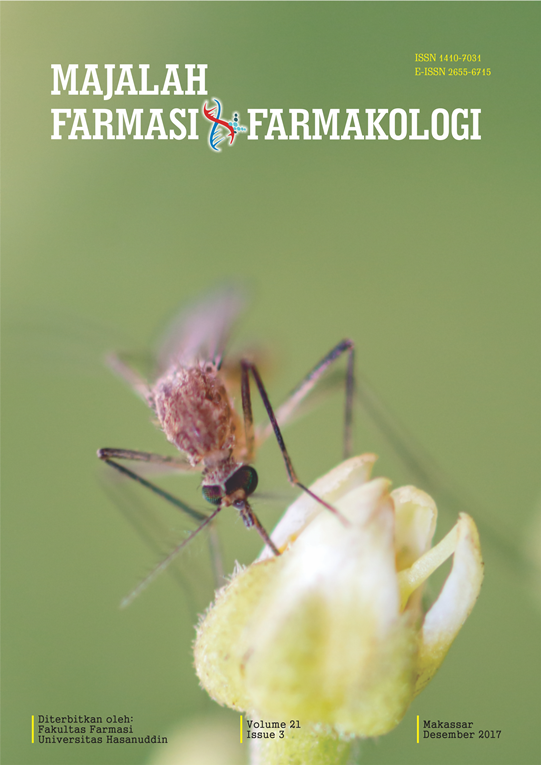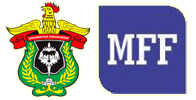DOCKING MOLEKULER SENYAWA 5,5’-DIBROMOMETILSESAMIN
Abstract
Docking molekuler merupakan simulasi secara komputasi yang digunakan untuk memprediksi ikatan antara obat/ligan dan reseptor/protein dengan memasangkan suatu molekul kecil (ligan) pada sisi aktif dari reseptor, yang sampai saat ini banyak digunakan dalam proses penemuan dan pengembangan obat baru dengan aktivitas yang lebih baik. Penelitian ini bertujuan untuk melakukan docking molekul dan pemodelan struktur senyawa 5,5’-dibromometilsesamin yang diduga memiliki afinitas terhadap reseptor SMO. Pada penelitian ini, terlebih dahulu dilakukan pemodelan senyawa 5,5’-dibromometilsesamin dan dilakukan optimasi geometri senyawa 5,5’-dibromometilsesamin. Proses docking yang dilakukan melalui tahap preparasi ligan, preparasi reseptor dan simulasi docking. Proses preparasi ligan dilakukan dengan protonasi senyawa 5,5’-dibromometilsesamin. Proses preparasi reseptor dilakukan dengan menghapus molekul air pada reseptor kemudian dilakukan protonasi reseptor. Proses simulasi docking dilakukan setelah proses preparasi ligan dan reseptor telah selesai. Hasil penelitian menunjukkan bahwa molekul 5,5’-dibromometilsesamin memiliki afinitas pada reseptor SMO (kode pdb 4O9R) dengan Docking score yaitu -7.8500 dan residu asam amino yang terikat yaitu Glu518.References
Abidi, A., (2014), Hedgehog signaling pathway: A Novel Target for Cancer Therapy: Vismodegib, A Promising Therapeutic Option in Treatment of Basal Cell Carcinomas. IJP, 46: 3-12.
Ferreira L.G. et al. (2015). Molecular Docking and Structure-Based Drug Design Strategies. Molecules, 20: 13384-13421.
Husain F., Rifai Y., & Tahir D. (2014). Penentuan Bobot molekul dan Karakterisasi Kristalografi Senyawa Derivat Sesamin sebagai Kandidat Antikanker Penghambat Glioma (GLI). Fakulas Farmasi. Universitas Hasanuddin, Makasar: 1-6.
Kitchen D.B. et al. (2004). Docking and Scoring in Virtual Screening for Drug Discovery: Methods and Applications. Nat.Rev.Drug.Disc., 3: 935-949.
Mohan V. et al. (2005). Docking: Successes and Challenges. Current Pharmaceutical Design, 11(3): 323-333.
Mukesh B. & Rakesh K. (2011). Molecular Docking: A Review. IJRAP, 2(6): 1746-1751.
Pranowo H.D. & Hetadi A.K.R. (2011). Pengantar Kimia Komputasi. Penerbit Lubuk Agung, Bandung: 1-118.
Pranowo H.D. (2009). Teknologi Informasi dalam Mendukung Riset di Bidang Kimia. Prosiding Seminar Nasional Kimia dan Pendidikan Kimia: 10-24.
Reddy A.S. et al. (2007). Virtual Screening in Drug Discovery – A Computational Perspective. Current Protein and Peptide Science, 8(4): 329-351.
Young D.C., Wiley J., & Sons. (2011). Computational drug design – A Guide for Computational and Medicinal Chemists; a book review. J Pharm Pharmaceut Sci, 14(2): 215-216.
Downloads
Published
Issue
Section
License
The copyright to this article is transferred to Universitas Hasanuddin (UNHAS) if and when the article is accepted for publication. The undersigned hereby transfers all rights in and to the paper including without limitation all copyrights to UNHAS. The undersigned hereby represents and warrants that the paper is original and that he/she is the author of the paper, except for material that is clearly identified as to its original source, with permission notices from the copyright owners where required. The undersigned represents that he/she has the power and authority to make and execute this assignment.
We declare that:
- This paper has not been published in the same form elsewhere.
- It will not be submitted anywhere else for publication prior to acceptance/rejection by this Journal.
- A copyright permission is obtained for materials published elsewhere and which require this permission for reproduction.
Furthermore, I/We hereby transfer the unlimited rights of publication of the above-mentioned paper in whole to UNHAS The copyright transfer covers the exclusive right to reproduce and distribute the article, including reprints, translations, photographic reproductions, microform, electronic form (offline, online) or any other reproductions of similar nature.
The corresponding author signs for and accepts responsibility for releasing this material on behalf of any and all co-authors. This agreement is to be signed by at least one of the authors who have obtained the assent of the co-author(s) where applicable. After submission of this agreement signed by the corresponding author, changes of authorship or in the order of the authors listed will not be accepted.


